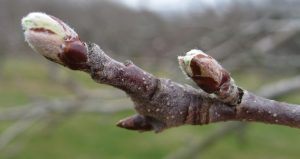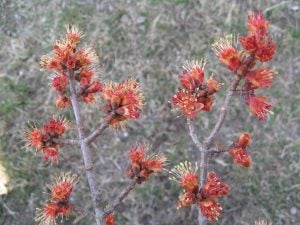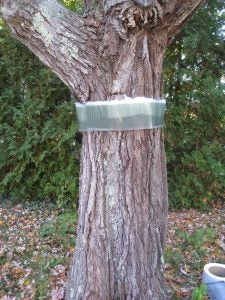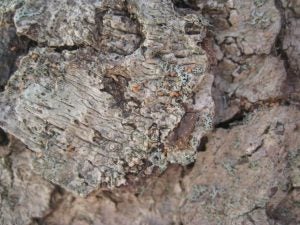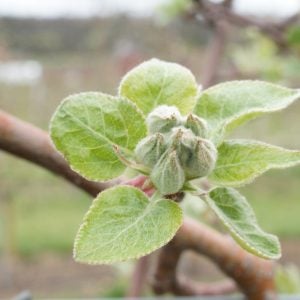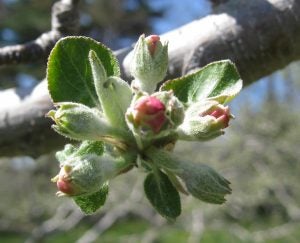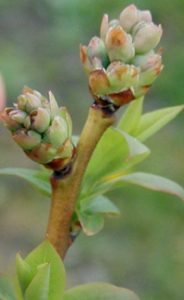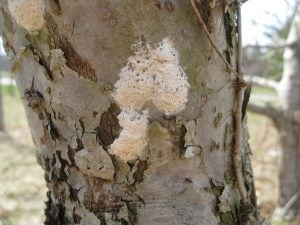Winter Moth March 22, 2019
Over the last decade, winter moth eggs started hatching anywhere from mid-March to mid-April, primarily depending on temperature. I don’t expect eggs to hatch until after red maples start blooming and when McIntosh apple buds crack open and expose a little bit of green tissue. Hopefully this is still a few weeks away.
Fig 1.McIntosh apple bud at “green tip”, when winter moth eggs tend to start hatching.
Fig 2. Red Maple tree blooming. Time when winter moth eggs tend to start hatching.
Tree wraps were set up in early November, 2018, to monitor eggs at 5 locations in RI and one location in Massachusetts. One of these 6 sites was a new monitoring site, the other 5 sites were monitored in previous years. In November and December, as female winter moths climbed trees and encountered tree wraps, female moths deposited eggs below the wraps, aggregating eggs, and making it easier to monitor egg hatch. Winter moth eggs are orange now, but turn blue a couple of days before hatching. This trait makes it very handy for monitoring egg hatch!
Fig 3. Bug Barrier tree wrap set up in November to aggregate winter moth eggs.
Fig 4. Tiny, orange dots are eggs of winter moth caterpillars.
Tree wraps were removed last week and 3 of 5 locations have many fewer eggs than in 2018! I wish the egg population was down in all locations, but that is not the case. This year there are fewer eggs on monitored trees in Little Compton, Wakefield, and Franklin, MA. The number of eggs is about the same in 2018 and 2019 in Kingston; and, unfortunately, in Charlestown, I found many more winter moth eggs this spring than last spring. The sixth monitored site, a new site in Portsmouth, has a rather large number of eggs, but I can’t compare this to previous years. Just because one tree in a community has a large number of eggs does not mean the whole community is doomed! I’m not sure what it does mean, and over the next couple of months we will see what is going on with winter moths.
Overall, it seems that winter moth populations have declined in southeastern New England. Over the winter, many people commented to me that they did not see many male moths flying in November and December, unlike previous years.
I don’t think landscape trees will need protecting from winter moth caterpillars this year, nor did I think any landscape trees needed protecting in 2018. I didn’t see any trees defoliated by winter moth last year. If landscape trees do need protecting, probably the best time to spray will be late April or early May after trees leaf-out, while caterpillars are still small, and before excessive feeding damage has occurred.
For fruit (apple, pear, and blueberry) I think growers can wait until buds have developed and then determine in an insecticide treatment is warranted. In past years, when we were under outbreak conditions, growers needed to spray at egg hatch to protect flower buds from winter moth caterpillars entering buds in large numbers. Now, since our winter moth population is much lower, I think we can wait until caterpillars are a few weeks old, and flower buds are more developed, before deciding if an insecticide treatment is needed. The best time to look for caterpillars will be sometime in April or May when apples trees are at the tight cluster bud stage, or bud separation stage (see pictures below). It is much easier to control winter moth caterpillars weeks after eggs hatch rather than try to kill them when they are newly hatched caterpillars and before they enter buds. And if an insecticide application is warranted, probably only one spray will be needed.
Fig 5. Apple flower bud at ‘Tight Cluster’ bud stage.
Fig 6. Apple flower bud at bud separation.
Fig 7. Blueberry flower buds at ‘Tight Cluster’ bud stage. Blueberry flowers are more difficult to check for winter moth caterpillars than apple buds.
Winter moth caterpillars are pretty easy to kill once they are a few weeks old and moving from bud to bud. B.t. kurstaki products (Bacillus thuringiensis kurstaki) such as DiPel, Thuricide (for backyard growers), and Biobit work well controlling winter moth caterpillars, and these products kill only caterpillars. Many insecticides also kill winter moth caterpillars, but these kill other insects as well. Spinosad products are very effective, but do not spray spinosad near open flowers because it will kill bees for up to 3 hours after applying. Spinosad products are Delegate and Conserve (for commercial growers), Entrust (for organic, commercial growers), and Captain Jack’s Deadbug Brew (for backyard growers).
I don’t see many gypsy moth egg masses in RI, but several communities in Massachusetts have many overwintering egg masses. I was surprised to see many egg masses on a tree in Franklin, MA, only a few miles north of RI! Counties in Massachusetts with high numbers of overwintering gypsy moth egg masses include Essex, Hampden, Hampshire, Middlesex, Norfolk, Plymouth, and Worcester. Hopefully spring will be rainy enough for gypsy moth caterpillars to be managed by the fungal pathogen, Entomophaga maimaiga, otherwise gypsy moth caterpillars could build up again!
Fig 8. Gypsy moth egg masses.
 Home
Home Browse
Browse Close
Close Events
Events Maps
Maps Email
Email Brightspace
Brightspace eCampus
eCampus



